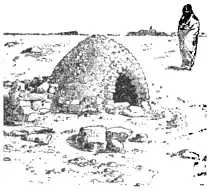Horno
Horno (/ˈɔːrnoʊ/ AWR-noh; Spanish: [ˈoɾno]) is a mud adobe-built outdoor oven used by Native Americans and early settlers of North America.[1] Originally introduced to the Iberian Peninsula by the Moors, it was quickly adopted and carried to all Spanish-occupied lands.[2] The horno has a beehive shape and uses wood as the heat source.[3] The procedure still used in parts of New Mexico and Arizona is to build a fire inside the horno and, when the proper amount of time has passed, remove the embers and ashes and insert the bread to be cooked. In the case of corn, the embers are doused with water and the corn is then inserted into the horno to be "steam"-cooked. When cooking meats, the oven is fired to a "white hot" temperature (approximately 650 °F or 340 °C), the coals are moved to the back of the oven, and the meats placed inside. The smoke-hole and door are sealed with mud. A twenty-one-pound turkey will take 2½ to 3 hours to cook.[3]
_at_Taos_Pueblo_in_New_Mexico_in_2003.jpg.webp)

Horno is the usual Spanish word for "oven" or "furnace", and derives from the Latin word furnus.
See also
| Wikimedia Commons has media related to Hornos. |
- Adobe bread
- List of ovens
- Primitive clay oven
- Kemence (in Hungarian)
References
- Devon Peña; Luz Calvo; Pancho McFarland & Gabriel R. Valle (2017). Mexican-Origin Foods, Foodways, and Social Movements: Decolonial Perspectives. University of Arkansas Press. pp. 153–156. ISBN 9781610756181. Retrieved 28 October 2019.
- Green, Rayna (1999). The British Museum Encyclopedia of Native North America. London: British Museum Press. p. 4. ISBN 0-253-33597-3. Retrieved 2 June 2012.
- Mary Ellen Snodgrass (2004). Encyclopedia of Kitchen History. Fitzroy Dearborn. pp. 493–494. ISBN 1-57958-380-6. Retrieved 15 June 2012.